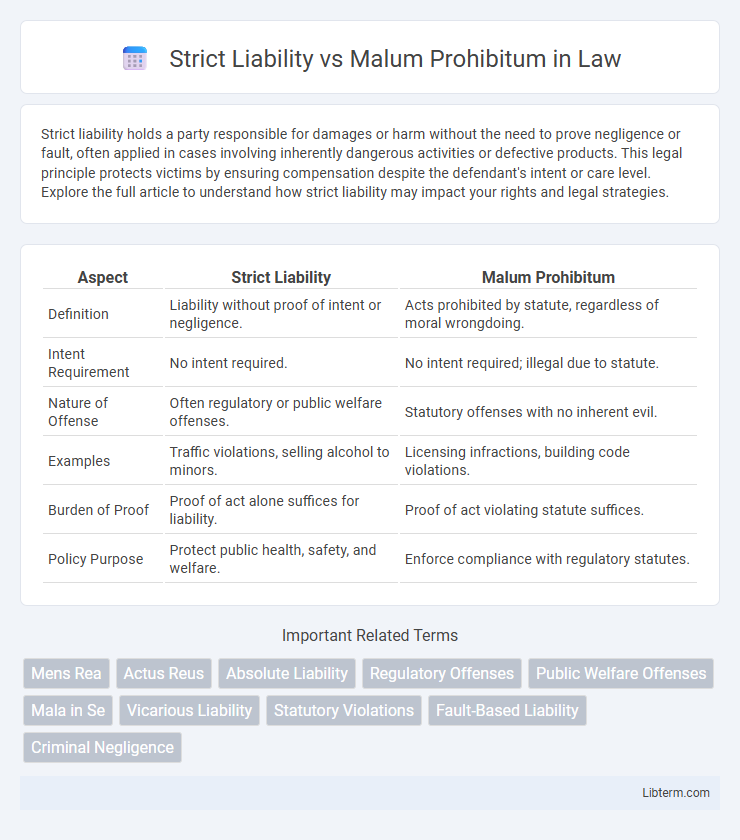Strict liability holds a party responsible for damages or harm without the need to prove negligence or fault, often applied in cases involving inherently dangerous activities or defective products. This legal principle protects victims by ensuring compensation despite the defendant's intent or care level. Explore the full article to understand how strict liability may impact your rights and legal strategies.
Table of Comparison
| Aspect | Strict Liability | Malum Prohibitum |
|---|---|---|
| Definition | Liability without proof of intent or negligence. | Acts prohibited by statute, regardless of moral wrongdoing. |
| Intent Requirement | No intent required. | No intent required; illegal due to statute. |
| Nature of Offense | Often regulatory or public welfare offenses. | Statutory offenses with no inherent evil. |
| Examples | Traffic violations, selling alcohol to minors. | Licensing infractions, building code violations. |
| Burden of Proof | Proof of act alone suffices for liability. | Proof of act violating statute suffices. |
| Policy Purpose | Protect public health, safety, and welfare. | Enforce compliance with regulatory statutes. |
Understanding Strict Liability
Strict liability imposes responsibility for damages or injuries regardless of intent or negligence, emphasizing the outcome rather than the actor's state of mind. This legal principle commonly applies in cases involving inherently dangerous activities, product liability, or statutory offenses where proving fault is unnecessary. Understanding strict liability highlights how the law prioritizes victim protection over the defendant's intent in certain regulatory or safety contexts.
Defining Malum Prohibitum
Malum Prohibitum refers to actions that are considered wrong because they are prohibited by law, rather than inherently immoral or evil. Unlike strict liability offenses that impose responsibility regardless of intent, malum prohibitum violations often involve regulatory or statutory breaches, such as traffic violations or licensing infractions. These offenses emphasize compliance with legal standards to maintain public order rather than punishing morally reprehensible conduct.
Key Differences Between Strict Liability and Malum Prohibitum
Strict liability offenses do not require proof of intent or negligence, as liability is imposed solely based on the act itself, whereas malum prohibitum offenses are violations of statutory regulations established to maintain public order and safety, regardless of moral wrongdoing. Strict liability typically applies to inherently hazardous activities or public welfare laws, while malum prohibitum crimes are defined by the prohibition of conduct that is not inherently immoral but is illegal by statute. The key difference lies in strict liability's focus on the actus reus without mens rea, contrasted with malum prohibitum's emphasis on regulatory compliance and statutory violation rather than moral culpability.
Legal Foundations of Strict Liability
Strict liability in law holds defendants responsible for damages regardless of intent or negligence, emphasizing public safety and regulatory compliance. It is grounded in legal principles that prioritize preventive measures and risk allocation in areas such as environmental law, product liability, and statutory offenses. Unlike malum prohibitum offenses, which criminalize actions merely because they are prohibited by statute, strict liability imposes consequences even when wrongful intent is absent, reflecting a foundational approach to deterrence and compensation.
Historical Evolution of Malum Prohibitum
Malum Prohibitum offenses, historically rooted in the need to regulate emerging social order and public welfare, evolved distinctly from Malum in Se offenses, which are inherently wrong by nature. The concept of Malum Prohibitum arose prominently during the industrial revolution, when expanding government regulatory frameworks introduced crimes based on statutory prohibitions rather than moral wrongdoing. This legal evolution reflects society's shift toward prioritizing public safety and administrative control through legislated norms rather than solely relying on traditional notions of inherent immorality.
Examples of Strict Liability Offenses
Strict liability offenses include statutory rape, where consent is irrelevant, and traffic violations like speeding, where proving intent is unnecessary. Other examples encompass selling alcohol to minors and selling contaminated food products, emphasizing public safety over defendant intent. These offenses hold individuals accountable regardless of mental state to deter harmful conduct effectively.
Common Malum Prohibitum Crimes
Common malum prohibitum crimes, such as traffic violations and regulatory offenses, are offenses prohibited by statute rather than inherent immorality, contrasting with strict liability crimes where intent is irrelevant for conviction. Strict liability applies especially in public welfare offenses like selling alcohol to minors or environmental regulations, emphasizing compliance over intent to protect societal interests. Understanding the distinction clarifies enforcement priorities and legal defenses within criminal law frameworks.
Implications for Legal Defenses
Strict liability offenses impose responsibility without fault, limiting the availability of traditional legal defenses such as intent or mistake of fact. Malum prohibitum crimes, defined by statute as prohibited regardless of moral wrongfulness, allow defendants to argue lack of knowledge or reasonable mistake due to the regulatory nature of the law. Understanding the distinction informs defense strategy, emphasizing the importance of procedural compliance in malum prohibitum cases versus the inherent culpability in strict liability scenarios.
Controversies and Criticisms
Strict liability offenses eliminate the need to prove mens rea, sparking controversy over potential unfairness and disregard for defendant intent. Malum prohibitum crimes, defined by statutory prohibitions rather than inherent moral wrongness, face criticism for criminalizing behaviors without ethical culpability, leading to debates about over-criminalization. Both concepts challenge traditional justice principles by emphasizing regulatory compliance over moral blameworthiness, raising concerns about proportionality and individual rights.
Practical Impact on Criminal Law Enforcement
Strict liability offenses eliminate the need to prove mens rea, enabling law enforcement to prosecute violations efficiently, especially in regulatory and public safety contexts. Malum prohibitum crimes involve actions prohibited by statute without inherent moral wrongness, requiring authorities to focus on adherence to legal standards rather than intent. This distinction influences criminal law enforcement by streamlining case processing for strict liability offenses while demanding contextual evaluation for malum prohibitum violations.
Strict Liability Infographic

 libterm.com
libterm.com